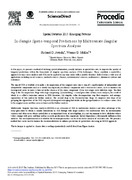| dc.contributor.author | Awichi, Richard | |
| dc.date.accessioned | 2017-02-17T06:37:53Z | |
| dc.date.available | 2017-02-17T06:37:53Z | |
| dc.date.issued | 2015 | |
| dc.identifier.citation | Awichi, R.O. and Müller, W.G., 2015. In-Sample Spatio-temporal Predictions by Multivariate Singular Spectrum Analysis. Procedia Environmental Sciences, 26, pp.19-23. | en_US |
| dc.identifier.uri | http://hdl.handle.net/20.500.12280/394 | |
| dc.description.abstract | In this paper, we present a method of utilizing spatial information, usually intrinsic in spatial data sets, to improve the quality of temporal predictions within the framework of singular spectrum analysis (SSA) techniques. Those constitute a model free approach to time series analysis and SSA can be applied to any time series with a notable structure. Indeed it has a wide area of application including social sciences, medical sciences, finance, environmental sciences, mathematics, dynamical systems and economics.
The aim of SSA is twofold: i) to make a decomposition of the original series into a sum of a small number of independent and interpretable components such as a slowly varying trend, oscillatory components and a structureless noise; ii) to reconstruct the decomposed series to make a forecast in the absence of the noise component. It has two stages each with two steps. The first stage is the Decomposition Stage with steps comprising: (i) embedding–a usual procedure in time series analysis; the result of which is a called a trajectory matrix in SSA literature; (ii) singular value decomposition step that computes and arranges eigenvalues of this matrix for further analysis. The second stage is the Reconstruction Stage: it comprises two steps of (i) grouping the eigenvalues of the SVD step and (ii) diagonal averaging that works on the grouped matrices to realize a series close to the original series and this series is then used for further analysis.
Multivariate Singular Spectrum Analysis (MSSA) is an extension of SSA to multivariate statistics and takes advantage of the delay procedure to obtain a similar formulation as SSA though with larger matrices for multivariate data. In environmental sciences and other areas where spatial data is an important focus of investigation, it is not uncommon to have attributes whose values change with space and time and an accurate prediction is thus important. Spatial dependence subsequently influences data analysis. The usual question asked is whether the location parameters can be of use in the analysis of such data sets. We present a method that can be used to harness the location attributes to enhance prediction of spatial data sets using an MSSA approach.
This technique is applied to climate data recordings (particularly rainfall data) from Upper Austria. | en_US |
| dc.language.iso | en | en_US |
| dc.publisher | Elsevier | en_US |
| dc.subject | Series Analysis | en_US |
| dc.subject | Inverse Distance Weighting | en_US |
| dc.subject | Spatial Dependence | en_US |
| dc.title | In-Sample Spatio-temporal Predictions by Multivariate Singular Spectrum Analysis | en_US |
| dc.type | Working Paper | en_US |


